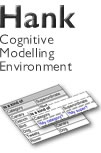 |
|
What is Hank?
Traditionally, cognitive modelling is taught either using general purpose programming languages (e.g. Prolog, Poplog) or using complex modelling environments (e.g. ACT*, Anderson, 1983; SOAR, Newell, 1990), both of which are generally too complex for undergraduate teaching.
Hank is a new cognitive modelling language, which is designed to be easy to grasp by non-programmers, simple enough to use on paper, yet powerful enough to build models of non-trivial psychological theories. Hank builds on our previous experience of using SOLO (Eisenstadt, 1992) and Prolog in an undergraduate cognitive psychology course, yet it is designed to overcome the shortcomings of both these approaches.
Hank is designed to meet the following requirements:
- Suitable for building cognitive models
- Suitable to describe processes
- Suitable for use in groups
- Suitable for 'programming on paper'
- Suitable for use by non-programmers
Hank is divided into two main parts, a database containing 'fact cards' and 'instruction cards' which define a model, and a question processor which answers questions by looking inside fact cards and obeying instruction cards, generating the model's behaviour. The question processor generates the model's behaviour using a workspace which looks like a comic strip storyboard of the model's behaviour. All these components are designed to be easy to grasp by non-programmers.
The database is drawn graphically, representing fact cards as small spreadsheets and instruction cards as flowcharts of connected questions against other fact and instruction cards. The question processor is represented as a simple and intuitive step-by-step procedure. The storyboard representation of the workspace enables people to act out their models by following a simple set of rules.
Hank was dreamt up, designed, and implemented by Paul Mulholland and Stuart Watt of the Knowledge Media Institute and Department of Psychology, at the Open University in the UK. Others who helped by giving us loads of great feedback (in more or less alphabetical order), Sandy Aitkenhead, Gillian Cohen, Trevor Collins, Thomas Green, Judy Greene, Clayton Lewis, Simon Masterton, Chris McKillop, Peter Naish, and Ingrid Slack. We'd like to thank them all. We'd also like to thank all those who tried out Hank while we were developing it.
'Hank' is not an acronym; it is named after, and as a tribute to, Hank Kahney, whose work on SOLO, and whose opinions on what cognitive modelling should be like, made Hank possible.
References
Anderson, J. R. (1983). The Architecture of Cognition. Harvard University Press.
Eisenstadt, M. (1992). Design Features of a Friendly Software Environment for Novice Programmers. In M. Eisenstadt, M. Keane, & T. Rajan (Eds), Novice Programming Environments: Explorations in Human-Computer Interaction and Artificial Intelligence. Lawrence Erlbaum Associates, pp3-30.
Newell, A. (1990). Unified Theories of Cognition. Cambridge, Massachusetts: Harvard University Press.